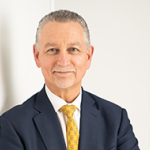Three years ago, the pandemic disrupted where and how people worked, forever changing the traditional workplace. Today, leaders are grappling with questions about how to move forward – when to return to the office, what work looks like today, and how to prepare for the future.
These questions and more are addressed in the new book Office Shock. It discusses why it’s necessary to use future-back thinking to anticipate directions of change, identifies spectrums of choices to guide decision making, and explores how to plan for more sustainable ways of working.
I recently spoke with Bob Johansen, Joseph Press, and Christine Bullen, authors and researchers at the Institute for the Future for my podcast, Tech Whisperers. Read on for their insights on how technology leaders can apply these concepts to their teams and organizations as they plan for the workplace of the future.
Roberts: The book talks about future-readiness and having clarity of direction, and clarity of intent. One of the ways you propose we get future-ready is this concept of the officeverse. What does officeverse mean to you?
Press: The officeverse is the concept that everyone should be more cognizant, more conscious, and more explicit about where and when they work. If we want to make choices about our climate impact, for example, it makes more sense – if it’s possible and convenient – to be working at home. If we want to increase innovation in the office, we need to be working face-to-face with people who are different from us, because that’s how you break out of the familiar concepts and mental models.
The idea of an officeverse is about empowering everyone to achieve those higher-level objectives by considering that when and where we work has a direct impact. Right now, everyone is asking questions like, “Do we go back to the office two days a week or three days a week? Do we work at home four days a week or three? Are we going to be as productive? Are we going to be as innovative?” We need to elevate the conversation to those deeper, more important spectrums of choice. What is the real impact we are trying to make, and how can our choices about the officeverse help or hurt?
[ Want to learn the key aspects that make up resilient IT culture - as well as the five common obstacles that may be standing in the way? Download the new eBook: Build a resilient IT culture ]
Roberts: The book talks about the seven spectrums of choice: Purpose, Outcomes, Climate Impacts, Belonging, Augmentation, Place and Time, and Agility. Could you explain what those are?
Press: What we aim to do with the seven spectrums is to be very conscious about the choices we are making. For example, the spectrum of augmentation is about trying to find the right balance for an organization and culture between what’s human-enabled and technology-driven. Each choice on the spectrum reflects that technology is in a very different place than it was 25 years ago, when IT was a back office. Now the choices that IT leaders make influence everything from customer experience to business outcomes. Leaders have to be intentional in these choices and understand the impact of each.
They cannot do this in a vacuum. Once choices have been made across those seven spectrums, they will need to be synchronized with other leaders in the organization who may have different points of view on what the best choices are. There also has to be some synchronization with the communities that organizations are engaging with or serving.
It’s not black and white. It should be an open conversation. There should be intent with flexibility – clarity on where are we going and flexibility on how we will arrive there.

(Image attribution © 2022 Institute for the Future)
Roberts: One spectrum you discuss is the spectrum of time and place – an important one because it’s where many leaders are starting. Why is it important for us to start there?
Johansen: It’s an obvious starting point, in a way – it’s understanding where we are going to work and when we are going to work. The Covid shutdowns weren’t an option for most of us. We were locked out and had to figure out a way. People working remotely were remarkably productive and were able to do office work with no offices. It was shocking in a positive way, as well as in a negative way, because it was unfair if you weren’t ready, if you didn’t have good bandwidth, if you had kids running around, or if you didn’t have a space to work. But it was more productive than anyone expected.
The choice now requires going back to basics and asking ourselves, how can we be better than we were? It’s not going back to the office, it’s going forward to something better, something that’s more productive, has a higher sense of belonging, a higher sense of cohesion, and a stronger sense of being future-ready. It all comes back to where and when work gets done.
So we’re giving you the language to talk about it. We’re giving you the framework to make those choices. But you’re going to be the one that has to make the choices and then has to bring the officeverse to life.
Roberts: Another spectrum is around purpose. Many leaders get stuck thinking about this because they’re looking at these questions through the lens they’ve developed after decades of experience. Christine, can you help us see these questions from a new lens?
Bullen: Purpose is the first thing that we want people to be thinking about in light of the office shock that they have been going through. It’s a question for organizational leaders - what is the purpose of your organization?
On the spectrum, we say that a purpose ranges from the individual to the collective. And it’s important to think about that because for an individual first starting out in the workplace, their purpose may be very straightforward in terms of supporting themselves and their family. But as they get further into their career, they can enlarge their thinking about a purpose that actually can make the world better. And the same thing is true for organizations – they may start out very focused on getting their business going, but later can think about how they can contribute to the world.
And in that sense, another spectrum – outcomes – is very closely related. You may start out with your primary outcome being profit, but then once you’re established and comfortable, you can think much larger, like bringing prosperity to the world, whether that world is local or much larger.
A good way to think about it is outcomes at the profit level are very much focused on how we reward our stockholders. We really need to think about outcomes for stakeholders, which includes everyone associated with the organization – employees, who are often not viewed as stakeholders, our customers, and our communities with whom we have very strong relationships and can impact in a significant way.
Roberts: I want to jump to the spectrum around agility. Every C-level leader is trying to build a more agile, resilient organization, so what does this look like?
Press: We refer to this as an archipelago of agility. The clearest signal of what more agility looks like in organizations comes from the gig economy. In the spectrum of outcomes, if the choice in that spectrum is for profit, then the gig economy turns into an opportunity for abuse in which the disproportionate value of work being done goes to a small group of owners.
Ideally, there will also be conversations about how to become an organization in which the culture is much more about open communication, shared choice-making, and shared decision-making. That should make this archipelago of agility more of a reality as we’re able to see those shifting groups of workers focused on specific outcomes and projects that they have been tasked to do. Within the context of a more prosperous economic model, there should be enough value to be shared among the entire archipelago.
Roberts: Another spectrum is about augmentation. You say we will all be cyborgs, part human, part computer. How do we leverage this to disrupt our industries, and what’s the opportunity here?
Johansen: There’s an opportunity and there’s an inevitability. There are some aspects of the future that are kind of on track. They’re trends – the sense of a trend is a pattern of change you can extrapolate from with confidence. There’s a trend here where humans are going to become more augmented. The challenge for us is how will we become more automated. The term we use in the book is “augmented intelligence.” Not artificial, but augmented, and the augmentation is inevitable. The nature of the augmentation – that’s our choice. And the choice over the next decade is defining what humans do best and what we want to keep for ourselves, and what computers do best and where we need to be augmented. We will all have to be super-minds 10 years from now. Many of you probably already are. But that’s going to be the price of entry – we’ll all have to be super-minds.
[ Also read: How to be the manager your IT team needs in 2023 ]
Roberts: One spectrum that’s near and dear to you is on the climate impacts. What role do you see CIOs playing here?
Bullen: Yes. CIOs have been dealing with climate impact for quite some time in three specific areas. One is the acquisition of technology – how we acquire it and whether we need to acquire it. Do we need to constantly throw things away and get something new? Perhaps not.
Second is this huge aspect of how we manage technology once we have it. Electricity usage and minimizing the environmental impact of our technology, for example.
And of course, finally, how technology is disposed of when it’s retired. This is a huge question that goes far beyond recycling. If you don’t own it, maybe you can give it back. You don’t have to recycle it. Maybe there are instances in which it could be redeployed somewhere else.
It’s kind of cradle to rebirth; the circular economy. And for CIOs, the circular economy is this whole area of acquiring, managing, and disposing of technology.
Roberts: Joseph, what are some practical steps that we can take as we write our own personal stories here?
Press: The shared story of the future is what we believe to be that secret sauce of future-back thinking. If you’re able to bring people together where they can tell stories that are meaningful to them – where they envision themselves, their organizations, and their communities with more purpose, with more outcomes, with more belonging – and then merge those into a shared vision of a future, that’s really powerful. Then you can begin to work backward and say, “If that’s our shared story of the future, what are going to be some of the experiences in that future? What’s next? What kinds of products, services, data, interactions, and policies might we have? What would all that feel like?” If we can define what’s next, then we can talk about what we need to do now to be able to bring that preferred future forward.





